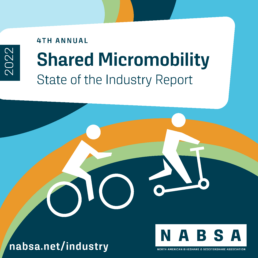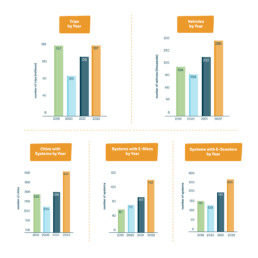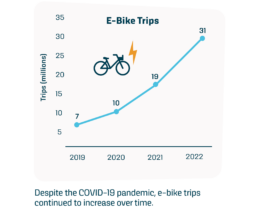Shared Micromobility Comes Back Stronger Than Ever, NABSA’s Fourth Annual Industry Report Shows

- Today, NABSA releases the fourth annual Shared Micrombility State of the Industry Report for North America – the only report of its kind tracking the trends, growth, and success of shared micromobility across North America.
- Shared micromobility ridership returns to pre-pandemic levels with at least 157 million trips taken across North America in 2022.
- Number of cities across North America with shared micromobility hits an all-time high with 401 cities.
- Shared micromobility offset approximately 74 million pounds of CO2 emissions (34 million kg) by replacing auto trips across North America in 2022.
August 10, 2023 – Today, the North American Bikeshare and Scootershare Association (NABSA), the nonprofit membership-based association representing public, private, and nonprofit organizations in shared micromobility, is pleased to present the fourth annual Shared Micromobility State of the Industry Report for North America.
The 2022 State of the Industry Report shows that shared micromobility ridership across North America returned to pre-pandemic levels in 2022, and reached the highest number of cities with systems across North America yet. In 2022, at least 157 million shared micromobility trips were taken in 401 cities across North America. Systems are expanding as well, with the highest number of deployed shared micromobilty vehicles to date– 289,000.

“Shared micromobility has come back stronger than ever, and is, year-over-year, demonstrating its value and importance in the transportation ecosystem,” said NABSA Executive Director Sam Herr. “Shared micromobility is poised to make its greatest impact yet, but where we go from here is a choice for policymakers, government leaders, and funders. Now is the time to make big investments in scaling shared micromobility at all levels to realize the full potential of shared micromobility as a climate action tool, and one that fosters more equitable public transportation.”
The 2022 report shows that shared micromobility offset approximately 74 million pounds of CO₂ emissions (34 million kg) by replacing car trips. Thirty-seven percent of shared micromobility trips continue to replace car trips, and 64% of riders report that they used shared micromobility to connect to transit. In these ways, shared micromobility is a powerful climate action tool that helps to decarbonize transportation.
The continued trend and popularity toward shared micromobility electrification only amplifies these impacts. Despite the COVID-19 pandemic, bikeshare trips made on e-bike have continued to increase over time, from 7 million in 2019 to almost 31 million in 2022, and e-bikes were ridden approximately 56% more than pedal bikes in systems that have both. E-scooter trips increased as well, with 10 million more trips in 2022 than in 2021. About 65% percent of total shared micromobility trips taken in 2022 were made on e-bikes and e-scooters, and they accounted for well over half of the total vehicles deployed across North America.


New this year, the State of the Industry Report captured industry innovation trends. Many in 2022 had to do with electrification. Importantly, 2022 was a break-out year for the incorporation of charging stations for electric shared micromobility devices, which helps to scale electric shared micromobility. NABSA will be publishing a paper on this topic soon.
“We must take a holistic approach to charging infrastructure when supporting micromobility,” Bridget Sanderson, coordinator for the Coalition Helping America Rebuild and Go Electric (CHARGE), which includes more than 55 members from the public, private and nonprofit sectors that support an equitable transition to cleaner transportation options. “Zero-emission cars, scooters and bikes work together to serve the many needs of a community and so too must its charging infrastructure. We look forward to using NABSA’s latest resources to support micromobility projects that help more people get where they need to go safely and affordably.”
This year, the report also features case examples demonstrating how shared micromobility is not just an urban amenity, but also provides meaningful benefits to rural communities, and a feature on US state tax policies that support shared micromobility mode choice to advance climate, equity, health, and transportation goals.
Shared micromobility continues to remain at the forefront of transportation equity with 88% of systems offering discount programs, 74% offering alternative payment options, 70% incorporating geographic distribution policies, and 69% offering education and outreach programs. It also provides low-cost access to physical activity, and in 2022 North Americans gained almost 18.7 million additional hours of physical activity by riding shared micromobility for new trips and by replacing motorized trips. NABSA also introduced new diversity, equity, and inclusion metrics on shared micromobility industry leadership in this year’s report, as part of NABSA’s ongoing Workforce DEI initiative. NABSA will be releasing an update to our Workforce DiversityToolkit for Shared Micromobility at our upcoming Annual Conference later this year.
The fourth annual Shared Micromobility State of the Industry Report demonstrates and confirms shared micromobility’s success, growth and impact over the last four years in communities across North America, and its reliability and effectiveness as a tool for transportation equity and climate action.
NABSA worked with Toole Design and the University of California Berkeley Transportation Sustainability Research Center to help develop the report. The report is composed of survey results, statistics gathered from performance reports released by shared micromobility systems, and data from GBFS. In addition to the metrics shared above, more information about year-over-year trends, mode shift, benefits of shared micromobility, equity programs, trip and vehicle trends, system statistics by size, operating characteristics, shared micromobility and transit, and shared micromobility policy can be found in the report.
Both an English and Spanish version of the report is available for download at nabsa.net/industry.
In addition to the annual Shared Micromobility State of the Industry Report, NABSA convenes an Annual Conference. The NABSA Annual Conference is the only shared micromobility-focused conference globally, and brings together shared mobility leaders, practitioners, operators, and equipment and technology providers to actively shape the future of shared micromobility. This year’s conference will be held September 19-22 in Hamilton and Toronto, Ontario, Canada. More information about the conference and registration can be found at nabsa.net/2023conference/.
The North American Bikeshare & Scootershare Association (NABSA) collaborates across sectors to grow shared micromobility and its benefits to communities, creating a more equitable and sustainable transportation ecosystem. NABSA is the industry’s membership organization with representation from system owners, operators, host cities, equipment manufacturers, and technology providers.
